6 Best Exercises to Help Pelvic Girdle Pain During Pregnancy
If you are pregnant, most likely you’ve felt an ache or pain in your pelvis or low back at some point. You may be experiencing pelvic girdle pain which is common and affects 1 in 5 pregnant women. [1] The good news is there are exercises to help manage pelvic girdle pain so you can have a more enjoyable pregnancy.
Everyone is different and there is not a one size fits all approach to dealing with pelvic girdle pain. However, exercising prior to pregnancy and during pregnancy has been shown to help manage or prevent pelvic girdle pain. So if you want to feel strong in your pregnancy and move without pain, you’ll want to try these 6 exercises to help your pelvic girdle pain!
What is Pregnancy Related Pelvic Girdle Pain
Pregnancy related pelvic girdle pain is an umbrella term for aches and pains in the pelvic joints during pregnancy. This results in pain being felt in the pubis symphysis joint, sacroiliac joints (SI joint), sacrum, coccyx, lower back, groin, perineum, hips, or the thighs.
Some women report pain in one area, while others feel pelvic girdle pain in multiple areas. Below is the anatomy of the back of pelvis and the common pain points associated with pelvic girdle pain.


Many women report pain at the pubic symphysis as well as some of these other common pain points located in the front of the pelvis.


You may notice pain during activities, such as walking, standing on one leg while putting on pants, rolling over in bed, getting in and out of a car, and having sexual intercourse.
Pelvic girdle pain can start at any point in pregnancy, however, it seems to be more prevalent in the second and third trimesters. The degree of pain will also vary from minor to severe. For about 93% of women the pain dissipates 3 months after birth.
Functions of the Pelvis
The pelvis is a stable and resilient structure! It has many important functions, such as supporting the spinal column and organs, and protecting some reproductive, digestive, and urinary organs. Your pelvis allows you to walk, transfer weight from the upper to lower body, and is crucial in posture and stability. It’s also the attachment point for some of the strongest and largest muscles in the body, like the glutes, hamstrings, and lats.
During pregnancy, your pelvis supports and adapts to the growing baby. The hormone Relaxin loosens the pelvic ligaments and joints that allows for this adaptation. Relaxin’s effects also assist in opening the pelvis for an easier birth. The pelvis’ role in transferring weight and maintaining posture also means it must adjust to the increased weight gain and changes in weight distribution during pregnancy.
Causes of Pregnancy Related Pelvic Girdle Pain
It’s important to start by noting that the pelvis is meant to adapt during pregnancy and can withhold the demands placed on it to carry and birth a baby. You are not broken if you feel pelvic pain and you are not harming yourself or your baby by moving when you feel the pain. If your pain is making it hard for you to walk or move, you should consult your doctor or midwife and seek other treatment options.
Also, the true cause of pregnancy related pelvic girdle pain is unknown and more than likely there are multiple factors at play.
One of the most common theories of pregnancy related pelvic girdle pain is that the hormone relaxin allows additional movement in the pelvic joints causing them to move unevenly. This may result in increased sheer forces across the pelvic joints causing pain. [3] Like mentioned above, relaxin is important because it helps to loosen the joints of the pelvis to help it open for birth. However, there is no evidence that the effects of relaxin result in the symptoms of pelvic girdle pain [4].
Another possible reason for pelvic girdle pain during pregnancy is pelvic asymmetry. Since the pelvis is responsible for transferring load from the trunk to lower body, changes in posture and alignment can put stress on the pelvic ligaments and structures. The weight of the baby can also put extra pressure on the pelvis, which may stretch and weaken the pelvic floor. Weakening along with postural changes can result in poor movement patterns and pelvic asymmetry. [2]
There are some risk factors for the prevalence of pregnancy related pelvic girdle pain.
These include:
- Previous pain or trauma to pelvis or low back
- BMI >25
- Strenuous work
- Pelvic Girdle Pain in previous pregnancies
- Smoking
- High levels of stress
- Depression
There may not be a single culprit to your pain, but we do know that with pregnancy comes normal changes, such as increased pelvic width, hormonal changes, extra pressure on pelvic floor, weight gain, and changes in posture, such as favoring an anterior pelvic tilt. All of these factors can lead to developing muscular imbalances and put extra stress on ligaments and structures.
Can you still exercise during pregnancy with pelvic girdle pain
Yes! If you have mild to moderate pelvic girdle pain you may find exercising tolerable. The key is not to overdo exercise and to avoid exercises that make your pain worse. Below, we will cover how to modify exercises to limit pelvic girdle pain.
These exercises are also safe for each trimester. Lying on your back starting in your second trimester is still safe as long as you aren’t doing it for long periods of time. If you start to feel dizzy or nauseous you should roll to your side and sit up. For more in depth exercise modifications for each trimester you can check out this blog.
Why would exercises help pregnancy related pelvic girdle pain
It used to be thought that nothing could be done to treat pregnancy related pelvic girdle pain since it was a hormonal issue. Women were advised to avoid movement, rest, keep their legs together, and to use crutches or support belts.
Though it’s true that pain would decrease with inactivity, as soon as they continued their normal daily activity the pain would return.
It is now known that exercise during pregnancy has so many benefits and is recommended! Exercise may also help reduce the severity of pelvic girdle pain during and after pregnancy. [5]
*Disclaimer – If you are a postpartum, pregnant or have any other health conditions, make sure you always seek the advice of your physician or other qualified health care provider. Content on this blog should not be considered a substitute for professional medical advice, expertise, or treatment. Also, this post may include Amazon affiliate links which means I would earn a small commission if you decide to make a purchase through the link. You can read my full disclaimer here.
6 Best Exercises to Help Pregnancy Related Pelvic Girdle Pain
Strengthening the glutes, core (lower abdominals and obliques), hamstrings, adductors, and pelvic floor muscles will help support the pelvis and keep it moving more symmetrically. These muscles also help aid in posture, alignment, and will help you keep up with the increased pressure demands with growing baby which can effect your pelvis.
Working on strengthening is important and so is relaxation. Often with pain people will tend to muscles guard or tighten up when moving painful areas. Excessive tightening can cause further imbalances and pain. This is why it’s important to focus on relaxing as well.
Tips for exercising while pregnant or with pelvic girdle pain:
- Make sure you are using a diaphragmatic connection breath with each exercise.
- Throughout the day practice “letting go” or relaxing the pelvic floor muscles as well as in between sets.
- Practice proper posture and alignment when exercising and standing or sitting throughout the day. Think about stacking ribcage over a neutral pelvis and avoiding pelvic tilting.
- Avoid lifting at too high of an intensity. For more information about exercise intensity while pregnant check out this blog.
- Include a warm-up such as walking, mobility drills, or dynamic stretching. You should also include a cool-down to reduce stress and help relax pelvic floor.
- Don’t over do it. You might notice after an intense workout you have more pelvic girdle pain the next day. Remember exercising during pregnancy is meant to improve your pregnancy and help prepare you for birth and postpartum, not to get you in the best shape of your life.
- Just stay active! Remember anything is better than nothing, even in this case! Rest is important and so is movement. Find a balance that works for you.
Pelvic Girdle Pain Exercises
The exercises below will work to strengthen the glutes, core (lower abdominals and obliques), hamstrings, adductors, and pelvic floor and should be included in your regular prenatal exercise routine. Also included are some exercises to work the anterior and posterior oblique slings which will help to prevent the pelvis from shifting to one side or another, resulting in a more neutral alignment.
Sets and Repetitions: The sets and repetitions will depend on training level and goals. Below are recommendations for a beginner. To learn what sets, repetitions, and weight you should be using check out this blog.
Equipment:
- A pilates ball is also useful with helping you engage your core and pelvic floor during exercises, but it is not required to perform these exercises.
- Dumbbells are not required, but may be necessary to perform different variations or progress the exercise.
- A band could be used to add resistance and progress the exercise as well.
1. Squats
Squats are a great exercise to include in your prenatal program for general strength and to help with pelvic girdle pain. They are a functional exercise meaning you will be doing these in your everyday life as a mom. They also work multiple muscles, such as the muscles of your legs, glutes, core, and pelvic floor.
2-3 sets of 12-15 repetitions.
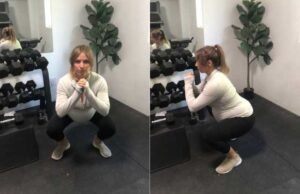
Technique:
- Start with feet a little wider than shoulder width a part with toes pointed out.
- With chest up, reach your hips back as you descend, inhale.
- Make sure weight is equally distributed on your entire foot.
- Think about pushing your knees out so they track over your toes.
- Pause for 1 second at the bottom, then exhale as you come back up.
2. Bridges
The bridge is a hinging movement that strengthens the glutes and hamstrings, relieves lower back pain, and gives your hip flexors a nice stretch. Place a ball between your knees and squeeze as you lift your hips for extra pelvic floor activation.
2-3 sets of 12-15 repetitions with 1 second pause at top.
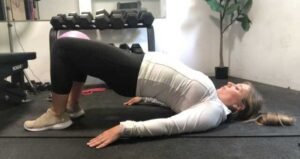
Technique:
- Start with feet a little wider than shoulder width a part and knees placed over your ankles.
- Push through your feet, squeeze your glutes, and exhale.
- Hips should fully extend, keep squeezing glutes!
- Pause for 1 second at the top, then inhale as you come back down.

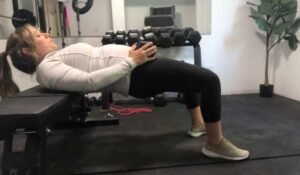
If getting up and down off the ground is too uncomfortable for you, you could perform a hip thrust on the bench as shown above.
3. Modified Coppenhagen Plank
The coppenhagen plank works the hip and groin muscles as well as obliques. It will help strengthen, balance, and add stability to the hips and pelvis. To make it easier you can bring your thigh up higher on the bench. If you find this too challenging, reverse your position by placing elbow on bench, bring in knee on bottom or squeeze ball.
2-3 sets of 6-8 repetitions each side.
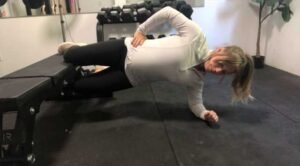
Technique:
- Start on your side with hips stacked and shoulder over elbow, place top knee on bench.
- Exhale and lift hips by pushing through your top knee and engaging core.
- Hold for time or lower back down to starting and repeat for reps.


If it is still too hard or you are experiencing pain when adjusting the placement of your top leg, try switching to a modified side plank on bench with hip adduction.
4. Half Kneeling Pallof Press with Rotation
The half kneeling pallof press with rotation is a great core and pelvic stability exercise working the anterior oblique sling. You can progress this exercise by hovering your back knee a couple inches off the ground. Or you can make this easier by kneeling and squeezing a pilates ball between knees to activate adductors.
2-3 sets of 6-8 repetitions each side.

Technique:
- Position a band or cable at about chest/sternum height while in a half kneeling position.
- With trunk upright, start with holding weight to chest, engage core, and extend arms out with exhale.
- Rotate arms to opposite knee, return to center, and pull weight back to chest.

5. Bird Dog
The bird dog exercise helps to improve core and pelvic stability by strengthening glutes, core, and back. Add in a row or pulldown with the opposite arm to work more of the posterior oblique sling. If you feel pelvic pain doing this exercise, keep your toes on the ground as you extend leg back.
2-3 sets of 6-8 repetitions with 1 second pause each side.

Technique:
- Start in table top position with shoulders over wrists, neutral spine, and engage core.
- Exhale and extend one arm and opposite leg out while maintaining neutral spine. Reach and engage. Think about balancing a cup on your back.
- Pause and then return to table top position and switch sides.


6. Child’s Pose Stretch
Performing the child’s pose stretch throughout pregnancy will help to relax your pelvic floor, which will make birthing easier and relax any overactive pelvic floor muscles that could be contributing to pelvic girdle pain. This pose will also stretch the back, which can be overworked and tightened throughout pregnancy.
Hold for 30-60 seconds.

Technique:
- Start in table top position with shoulders over wrists and neutral spine.
- With knees wide and feet close together, sink hips back towards heels.
- Reach arms in front so you feel a good lat stretch.
- Rest your head on the ground and relax here and breathe.

To get a deeper side body stretch, take the stretch to one side. You can also perform this stretch on an exercise ball, bench, or by elevating your chest with a pillow.

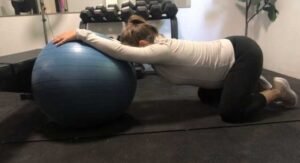
Exercise Modifications For Pregnancy Related Pelvic Girdle Pain
You should be able to continue many exercises you enjoy without pain with some adjustments. Below are some exercise modifications you can make if you do feel pain during a certain exercise. If you still feel pain with making modifications, then move onto the next exercise.
- Proper alignment – the first thing you will want to make sure is that you have proper alignment. Check to make sure your ribcage is stacked over pelvis and is not flaring. Then make sure your pelvis is in a neutral position and not tilted forward or back.
- Activate core – sometimes just by activating your core or pelvic floor is enough to stabilize and help take stress of pelvic ligaments.
- Squeeze a ball, towel, or yoga block between legs. This will help active pelvic floor, adductors, and core for stabilization.
- Narrow stance – instead of a wide/sumo stance, bring feet closer together. For example during a squat.
- Single-leg to bilateral exercise – if you notice pain with a single-leg exercise, like step-ups, switch to an exercise using both legs, like squat.
- Increase stability – you can do this by holding onto a wall, band, chair, or rings while performing an exercise like squat or lunge.
- Decrease load or change positioning – you could try lowering the amount of weight you are lifting or changing the position of the weight. For example, if doing a goblet squat with weight in front of chest, try holding kettlebell at your side.
- Reduce range of motion – To reduce range of motion don’t go as deep in a lunge, or you could use a bench higher than your typical depth to squat down onto. Reducing range of motion will also put less stress on your pelvic floor muscles.
Exercises to Help Pelvic Girdle Pain During Pregnancy: Conclusion
Pelvic girdle pain can really effect the quality and enjoyment of your pregnancy. Thankfully, with proper exercises, technique, and modifications you can help relieve some of this pain.
If there is one thing I want you to take away from this it is to stay active! Do movements that make you feel good and avoid movements that exacerbate your pain. Moving your body will make you feel better over all and will reap many other benefits as well.
Save this for later!

Similar Posts:
- A Complete Guide to Safe and Effective Exercise During Pregnancy
- Must-Do Core Exercise for Pregnancy and Postpartum: Connection Breath
- Strength Training Exercise Modifications During Pregnancy
- Important Strength Training Exercises You Should Do During Pregnancy
References:
1. RCOG Patient Information Committee. Pelvic Girdle Pain & Pregnancy. Royal College of Obstetricians & Gynecologists. https://www.rcog.org.uk/for-the-public/browse-all-patient-information-leaflets/pelvic-girdle-pain-and-pregnancy/#:~:text=PGP%20is%20common%2C%20affecting%201,treatment%20can%20relieve%20your%20pain.
2. Singh P. (2020). Pelvic girdle pain during pregnancy. Embrace Physiotheraphy. https://www.embracephysio.sg/pelvic-girdle-pain-during-pregnancy/
3. Stuge B. (2019). Evidence of stabilizing exercises for low back- and pelvic girdle pain – a critical review. Brazilian journal of physical therapy, 23(2), 181–186. https://doi.org/10.1016/j.bjpt.2018.11.006
4. Hansen, A., Jensen, D. V., Larsen, E., Wilken-Jensen, C., & Petersen, L. K. (1996). Relaxin is not related to symptom-giving pelvic girdle relaxation in pregnant women. Acta obstetricia et gynecologica Scandinavica, 75(3), 245–249. https://doi.org/10.3109/00016349609047095
5. Davenport, M. H., Marchand, A. A., Mottola, M. F., Poitras, V. J., Gray, C. E., Jaramillo Garcia, A., Barrowman, N., Sobierajski, F., James, M., Meah, V. L., Skow, R. J., Riske, L., Nuspl, M., Nagpal, T. S., Courbalay, A., Slater, L. G., Adamo, K. B., Davies, G. A., Barakat, R., & Ruchat, S. M. (2019). Exercise for the prevention and treatment of low back, pelvic girdle and lumbopelvic pain during pregnancy: a systematic review and meta-analysis. British journal of sports medicine, 53(2), 90–98. https://doi.org/10.1136/bjsports-2018-099400

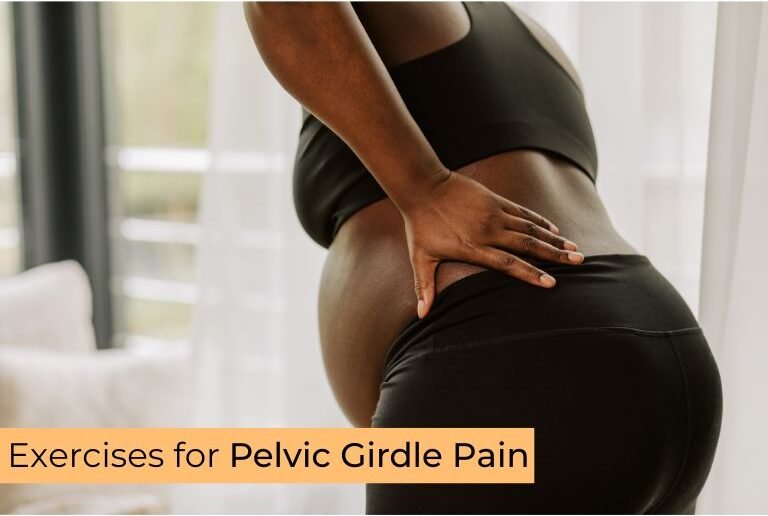
I admire your exercise ethics, you look amazing being pregnant 🩷🩵